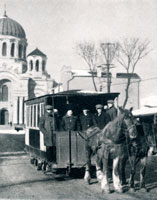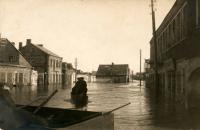 |
Panemunė (Aukštoji Panemunė, Lithuania) |
Life in Panemune, 1870[1]
By Rabbi Jeffrey A Marx
June 2022
“In the
1870's, Panemune had approximately 100 families and had but a single street,
four blocks long. This street
was divided by a square block of land into two parts.
One part was pure sand, and was called, “the sand islet.”
The other part, which contained a few dozen trees and some grass, was
called, “the grove” or “the woods.”
For that reason, the people of the town considered this thoroughfare
to be two streets. Each one
called the place where he lived "di gas" (“this street”), and the opposite
end, "yener gas" (“the other street”).
On the street there were to be found plain wooden houses and shacks,
some painted, some not, little fences, scrubby trees, and small gardens.
At the end of the town, toward the north, stood a magnificent forest.
Across the river and north, in the hills called "Grine Barg" (“Green
Mountain”) was the Seventh Fort in which Russian soldiers were billeted.[2]
At the southern end of town was a small house of worship for daily
prayer. Behind it was a
courtyard on which stood the large synagogue for holidays called "di shul".[3]
The cemetery was also at this end of town.
The northern end of town had a Catholic cemetery and another small
Jewish house of prayer.[4]
Surrounding the town on the other sides were fields and gardens belonging to
Jews.[5]
There was also a considerable tract of land owned by a German
nobleman.[6]
For the inhabitants of the town, the Niemon River had advantages and
disadvantages the whole year round.
During the summer months the people had a place in which to bathe, to
catch fish and to enjoy life generally; but the disadvantage was that, since
the bridge across the river to Kovno was some distance away, they had to pay
for being taken across in a "prom" (ferry‑rowboat).[7]
This business of taking passengers across the river was the cause of
a great deal of friction. The
representatives of the community had to decide who should get the contract
for the privilege. An elderly
man, by the name of Itzel, had a sort of monopoly on it, and as soon as
spring came and the river was cleared of ice, there were a great many
quarrels and arguments as to why this Itzel should be the privileged
character. It was quite a
business and would bring in about two hundred rubles for the season of six
months. The people were always
left dissatisfied, no matter how the controversy ended.[8]
In the winter, the river would freeze, so that the people would not
only walk across, but also ride across on sleds.[9]
However, the danger of the river overflowing in the spring, when the
ice started to break up, created anxiety and fear.
Often the river would rise and overflow to such a distance that many
of the houses were greatly damaged.
The whole town would then be cut off from Kovno, which meant from the
world.[10]
In Panemune lived Jews, Lithuanians, and Germans.
Among the Jewish functionaries were a town rabbi, two additional
rabbis who taught in the cheder, a cantor, "shochet" (ritual slaughterer),
and a shames (beadle).
Panemune also had a barber, two tailors, a storekeeper, shoemaker,
blacksmith, night watchman, a non-Jewish "voit" (mayor) and a day-time
policeman. There was also a
small "grocery" and "bakery" run by Keize Horvitz.
Most of the Jews made their living from gardening, tending to
orchards or renting near-by land, employing peasants to do much of the
labor.[11]
The Shatenstein family, for example, leased land from the Russian
government, felled the trees and exported the finished timber to Germany.
There was also a match-factory in the town, owned by Mordecai
Spindelman.[12]
During the day, the village was protected by a policeman appointed by
the mayor. He had nothing to do
but spend his time going from house to house, greeting everybody and getting
something to eat or drink. At
night, Yehuda Yamkeles, was employed as the night‑watchman.
He was a tall, lanky, overgrown man of about seventy, bent by ill
health. A victim of asthma, his
breathing was so bad that he could hardly speak.
His duties were to go through the streets from one end to the other
three times a night; but since this was too strenuous for him, he would walk
only a little way, and then shout at the top of his voice, "beware, I, the
night watchman, am here", in order to frighten thieves away.
This candidate for the grave was the guard and protector of Panemune
from sunset to sunrise. His
chief problem was how to kill time, but since he knew the psalms by heart,
he would spend the nights reciting psalms and praying to god for the welfare
of the Jewish people throughout the world.
The blacksmith, whose name was Nahum, was a man of great piety and
learning, well versed in the Talmud and Jewish lore.
It was not known where or how he had acquired his vast fund of
knowledge, and though he worked hard in his blacksmith shop from twelve to
fourteen hours a day, he still found time for study and discussion of knotty
problems of the Talmud with the rabbi.
The barber of the town, Aaron David,[13]
did not actually perform the duties of a barber, although he was known by
that title, since no one really shaved in those days.
He would cut hair once in a while, but chiefly he acted as assistant
to the physician when one was called in from Kovno to attend a patient.
Aaron David had influence with the authorities, because he could
speak their language and was a good mixer.
Some of the wealthy men he knew had to pay him tribute to hold his
tongue about their affairs, which were a bit cloudy, or about their sons'
trying to avoid military service.
Generally, he was feared and regarded as not very reliable, but he
was a "good fellow" with those he liked.”
[1]
The basis of the following section is taken from: Bernard Horwich,
My First Eighty Years, Argus Books, Chicago, 1939, which
describes Panemune in the 1870s.
[2]
It is
curious that he did not mention the 4th Fort which was just south of
Panemune. (See also, Dr.
Stanley Leavey, unpublished ms.: A Memoir of the Leavy and
Breakstone Families, 1971; interview with Ruth Wetter, 4/6/1987;
Wolf Bregstein letters, 4/18/1987 and 7/4/1987).
By the early 1900s, the sand islet had disappeared, though
the single street (now called, Vaidoto Gotveh) remained.
Most of Panemune consisted of barracks housing Russian
soldiers, as well as a war school, and the 4th Fort.
(Author Interview with Zalman Schames, 5/4/88.)
[3]
See blueprints, above. Wolf Bregstein stated that there was a
courtyard between the two synagogues and that the large synagogue
had two floors. (Wolf
Bregstein Interview by Philo Bregstein, Montevideo, 1996).
[4]
Both
schuls were destroyed by the Nazis during WWII.
In the early 1900s, the northern end of town was regarded as
the poorer part of town.
One side of the cemetery bordered the river. (Wolf Bregstein letter
to author, 4/18/1987; Wolf Bregstein Interview, 1996, Op. Cit.,
Zalman Shaymes Interview, 1988 Op. Cit.).
The cemetery should not be confused with one of the two
Kaunas Jewish cemeteries which is also across the river (Neris?)
from Kaunas and is entered through a military reservation.
(See Alex Friedlander's, "Genealogical Travel and Research in
Lithuania", Dorot, Vol. 12, Number 2, (Winter 90-91), p.12.)
[5]
Such
was the case with the other suburbs of Kovno, such as Slobodka and
Aleksota. (See Kagan,
Berl, Yidishe Shtet, Shtetlech un Dorfishe Yishuvim in Lite,
Simcha Graphic Associates, Brooklyn, 1990, p. 382.)
Early 1900s: “Everyone had a cow that was taken to the field
in the morning and brought back in the evening.
We also had a few horses behind the house….We ate a lot of
potatoes..and (in the Fall) was watermelon.” (Wolf Bregstein
Interview, 1996, Op. Cit.).
[6]
The German nobleman was Leopold von Ashfort.
He also owned cows, sheep, poultry, and had numerous servants
and employees. (Horwich,
Op. Cit., P. 11‑13).
[7]
The
closest bridge over the Niemon was in Alexota, about a mile away.
In the early 1900s, it was quite often the case that
travelers would come to the river bank only to find the boatman on
the other side. They
would then wave their arms, shouting in Russian: "Siuda! Siuda!"
(Over here!). The cost was
five kopeks. (Correspondence with Wolf Bregstein, 1987; Wolf
Bregstein Interview, 1996, Op. Cit.).
[8]
In the early 1900s one reached the outskirts of Kovno by crossing
the river, then traveling in sled or horse‑drawn carriage through
two suburbs called Shanzi and Carmelita.
From there, the Altstat (old city) was reached by a streetcar
pulled by horses.

Streetcar Pulled by Horses, Early 1900s
(Vytauto
Didžiojo mirties 500 metų sukaktuvėms paminėti albumas,
Kaunas, 1933, p. 374.
Courtesy of Kaunas County Public Library).
By
1936, it was possible to take a bus over the bridge.
(Wolf Bregstein letter, 4/18/1987; photo, Kaunas, ca.1905,
(BFC‑00382), Boris Feldblyum collection; Zalman Shaymes Interview,
1988, Op. Cit.).
[9]
“The Niemen (December 13, 1812) was just a long mass of blocks of
ice piled up and welded together by the breath of winter." (Napoleon's
Russian Campaign, Op. Cit.,p. 280). “By the end of December, we
reached the Polish border along the Memel River…I led my horse up
the river and crossed: it was filled high with pieces of ice, really
drifting ice. Pieces
from 15 to 18 inches thick drifted by…” (Jakob Walter, Op. Cit., p.
96). Panemune usually experienced four or five months of steady,
severe cold, with snowstorms.
In the early 1900s (but most certainly in the years before),
blocks of ice were taken from the Niemen, placed into pits in the
barns, and covered with salt to be used in preserving food (mostly
potatoes). The ice would
last as long as three months. (Wolf Bregstein Interview, 1996, Op.
Cit.). “The
ice from the river was often three feet thick.
It would be cut into blocks and placed inside an ice house,
which was a hut sitting on top of a deep hole cut into the ground.
The ice would be covered with saw‑dust and perishable foods
would be placed on top of these blocks.
The hut would keep its coolness well into the late spring.”
(Zalman Shaymes Interview, 1988, Op. Cit.).
[10]
The overflowing of the river also eroded the graves in the cemetery.
Young boys would be put to work collecting and reburying the
bones which the river had uncovered. (Zalman Schames Interview,
1988, Op. Cit.).

Flood in
Kaunas, Early 1900s
(Courtesy Kaunas County Public Library)
[11]
In the early 1900s, and, most certainly before, there were cherry,
apple and plum trees growing in Panemune. (Wolf Bregstein Interview,
1996, Op. Cit.).
[12]
(Kagan, Op. Cit., pp. 382, 383). In the early 1900s, kerosene
lamps were used for lighting.
(Wolf Bregstein Interview, 1996, Op. Cit.).
[13]
Aaron David Frock, b. circa 1938. Emigrated to the U.S. by 1894. He
was married to
Pessie Rivka Grauman.
(Correspondence with
Reva Sonkin Servoss and Shana Millstein).


Aaron David Frock Pessie Rivka Grauman
Web Page: Copyright © 2009-2022 Jeffrey A. Marx